Heal the Bay’s 10 Greatest Moments
A completely subjective list of when Heal the Bay has shone the brightest.
After 30 years of achievement, Heal the Bay can sometimes be taken for granted. Many Angelenos view us as they do their utilities – always on, always working, not requiring a lot of thought. So as we begin our fourth decade, here’s a crash-course reminder of how we’ve continuously healed the Bay.
1. SPAWNING A MOVEMENT
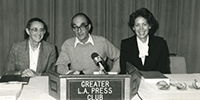 Meeting in her Westwood living room in spring 1985, housewife Dorothy Green and schoolteacher Howard Bennett mobilize a small squad of grassroots activists to conquer ongoing pollution in Santa Monica Bay. Brilliantly taking its mission as its name, Heal the Bay is officially born later that year.
Meeting in her Westwood living room in spring 1985, housewife Dorothy Green and schoolteacher Howard Bennett mobilize a small squad of grassroots activists to conquer ongoing pollution in Santa Monica Bay. Brilliantly taking its mission as its name, Heal the Bay is officially born later that year.
2. FIRST FIGHT
 Thanks to intense lobbying from Heal the Bay and a federal consent decree, Hyperion Treatment Plant agrees in October 1986 to stop dumping partially treated sewage into Santa Monica Bay. Sewage pollution levels in the Bay have since decreased by more than 90%.
Thanks to intense lobbying from Heal the Bay and a federal consent decree, Hyperion Treatment Plant agrees in October 1986 to stop dumping partially treated sewage into Santa Monica Bay. Sewage pollution levels in the Bay have since decreased by more than 90%.
3. THE FISHBONES
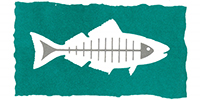 Volunteers Gabrielle Mayeur and Sherry Johannes unwittingly create one of L.A.’s great brands in October 1987. Their evocative and provocative fishbone logo creates instant recognition for the fledgling organization. Whether it’s slapped on a skateboard or a Prius, the fish remains a powerful marker for L.A.’s tribe of ocean lovers.
Volunteers Gabrielle Mayeur and Sherry Johannes unwittingly create one of L.A.’s great brands in October 1987. Their evocative and provocative fishbone logo creates instant recognition for the fledgling organization. Whether it’s slapped on a skateboard or a Prius, the fish remains a powerful marker for L.A.’s tribe of ocean lovers.
4. MAKING THE GRADES
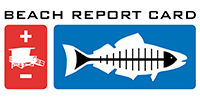 Aiming to protect the health of millions of ocean users, Heal the Bay publishes its first Beach Report Card in 1992, giving A-to-F grades to local beaches based on levels of bacterial pollution. Developed by outspoken executive director Mark Gold, the grading program shines a bright light and eventually helps secure $200 million in state funds to clean up chronically polluted beaches.
Aiming to protect the health of millions of ocean users, Heal the Bay publishes its first Beach Report Card in 1992, giving A-to-F grades to local beaches based on levels of bacterial pollution. Developed by outspoken executive director Mark Gold, the grading program shines a bright light and eventually helps secure $200 million in state funds to clean up chronically polluted beaches.
5. MINDS IN THE GUTTER
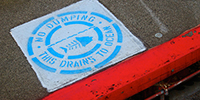 The first storm drains stenciled for our Gutter Patrol Program in October 1992 reminded would-be litterers that “This Drains to the Ocean.” Volunteers paint more than 60,000 catch basins with our message and logo over two years, connecting residents throughout L.A. County to their watersheds and our work.
The first storm drains stenciled for our Gutter Patrol Program in October 1992 reminded would-be litterers that “This Drains to the Ocean.” Volunteers paint more than 60,000 catch basins with our message and logo over two years, connecting residents throughout L.A. County to their watersheds and our work.
6. TAKING IT TO THE LIMIT
 Arguing that impaired water bodies in Los Angeles and Ventura counties are not being adequately remediated, Heal the Bay files an intent to sue the EPA in December 1997. A settlement compels the EPA to create 92 “Total Maximum Daily Load” limits over 13 years. With these measurable benchmarks in hand, Heal the Bay can now pressure dischargers to reduce pollution levels or meet stiff fines. The new TMDL model is copied nationwide.
Arguing that impaired water bodies in Los Angeles and Ventura counties are not being adequately remediated, Heal the Bay files an intent to sue the EPA in December 1997. A settlement compels the EPA to create 92 “Total Maximum Daily Load” limits over 13 years. With these measurable benchmarks in hand, Heal the Bay can now pressure dischargers to reduce pollution levels or meet stiff fines. The new TMDL model is copied nationwide.
7. SCALING UP
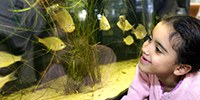 Heal the Bay gets into the aquarium business by acquiring UCLA’s Ocean Discovery Center in March 2003 for the princely sum of $1. The rechristened Santa Monica Pier Aquarium becomes a beachhead for our youth education programs. We’ve since inspired more than 1 million guests to become better stewards of our local ocean and watersheds.
Heal the Bay gets into the aquarium business by acquiring UCLA’s Ocean Discovery Center in March 2003 for the princely sum of $1. The rechristened Santa Monica Pier Aquarium becomes a beachhead for our youth education programs. We’ve since inspired more than 1 million guests to become better stewards of our local ocean and watersheds.
8. BANKING ON THE FUTURE
 After years of pressure from Heal the Bay, Washington Mutual agrees in November 2003 to sell Ahmanson Ranch at the headwaters of the Malibu Creek watershed to the State of California. The coalition of environmental advocates, scientists and celebrities successfully preserves 2,300 acres of open parkland and 20 miles of streams, thereby reducing pollution and protecting several threatened species.
After years of pressure from Heal the Bay, Washington Mutual agrees in November 2003 to sell Ahmanson Ranch at the headwaters of the Malibu Creek watershed to the State of California. The coalition of environmental advocates, scientists and celebrities successfully preserves 2,300 acres of open parkland and 20 miles of streams, thereby reducing pollution and protecting several threatened species.
9. YOSEMITES OF THE SEA
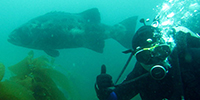 Ensuring a vibrant local ocean for generations to come, Heal the Bay’s policy staff leads an often contentious process with the state and anglers to create 52 Marine Protected Areas along the Southern California coast in January 2012. Our most biologically rich underwater habitats get a reprieve from human pressures, allowing depleted stocks in such areas as Malibu and Palos Verdes to recover and thrive.
Ensuring a vibrant local ocean for generations to come, Heal the Bay’s policy staff leads an often contentious process with the state and anglers to create 52 Marine Protected Areas along the Southern California coast in January 2012. Our most biologically rich underwater habitats get a reprieve from human pressures, allowing depleted stocks in such areas as Malibu and Palos Verdes to recover and thrive.
10. IT’S IN THE BAG
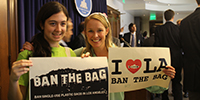 Heal the Bay’s programs and policy staff spearhead a plastic bag ban in Los Angeles, which in January 2014 becomes the largest city in the nation to take on Big Plastic. The unanimous City Council vote triggers a nationwide debate about sustainability and catalyzes other bans throughout the country.
Heal the Bay’s programs and policy staff spearhead a plastic bag ban in Los Angeles, which in January 2014 becomes the largest city in the nation to take on Big Plastic. The unanimous City Council vote triggers a nationwide debate about sustainability and catalyzes other bans throughout the country.


